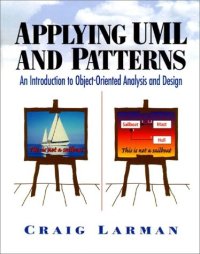
Ebook: Applying UML and Patterns
Author: Craig Larman
- Genre: Computers // Programming: Modeling languages
- Year: 1997
- Publisher: Prentice Hall PTR
- Edition: 1st
- Language: English
- djvu
This is a classroom text book for teaching the fundamentals of object oriented software development. At close to 500 pages, highly structured into 38 chapters, and with heavy use of diagrams throughout, this book attempts to be a thorough introduction to the subject. Key topics included are UML, iterative, incremental use case driven development, and the use of patterns in software design. The coverage of UML is complete (as of 1998, anyway), and the description of a proposed software development process is extensive, without actually referencing Rational's Unified Process. The discussion of patterns is also extensive and heavy reference is made to `Design Patterns' (aka GoF) and `System of Patterns' (aka POSA), and they are emphasised as recommended reading. The book mostly repackages material available elsewhere, but brings it together in a format suitable for course students. The author also tries with mixed success to introduce his own pattern catalog which he calls GRASP - general responsibility assignment software patterns - Expert, Creator, Low-Coupling, High-Cohesiveness, Controller, Polymorphism, Pure Fabrication, Indirection, Don't Talk To Strangers - which are applied to the development of collaboration diagrams, probably the most important activity in object oriented design.
The book really is introductory in nature and can be pedantic and repetitive at times. The POST case study developed through the course of the book is relatively simplistic, though the discussion of persistance frameworks in the final chapter is more advanced. In general I would recommend this book to someone wanting a textbook introduction to the subject, but there are plenty of other books that cover this material well, a number of which are in the included bibliography.
The book really is introductory in nature and can be pedantic and repetitive at times. The POST case study developed through the course of the book is relatively simplistic, though the discussion of persistance frameworks in the final chapter is more advanced. In general I would recommend this book to someone wanting a textbook introduction to the subject, but there are plenty of other books that cover this material well, a number of which are in the included bibliography.
Download the book Applying UML and Patterns for free or read online
Continue reading on any device:

Last viewed books
Related books
{related-news}
Comments (0)